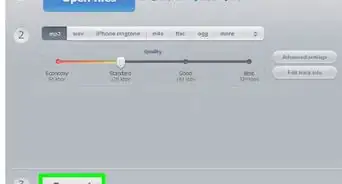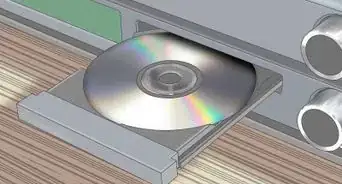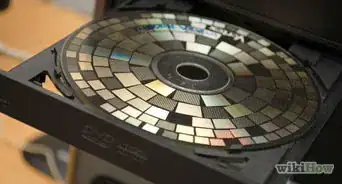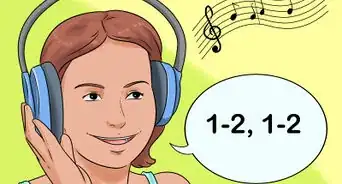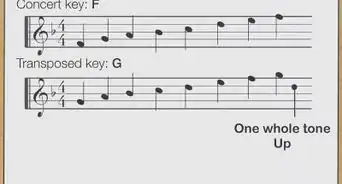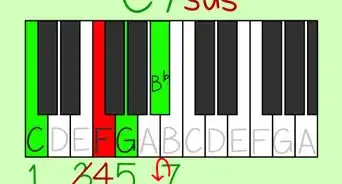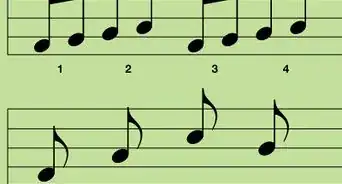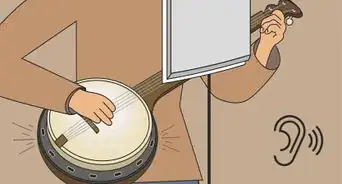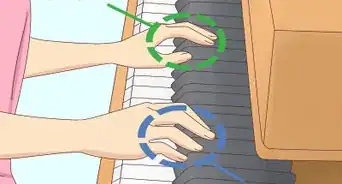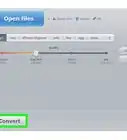This article was co-authored by wikiHow staff writer, Megaera Lorenz, PhD. Megaera Lorenz is an Egyptologist and Writer with over 20 years of experience in public education. In 2017, she graduated with her PhD in Egyptology from The University of Chicago, where she served for several years as a content advisor and program facilitator for the Oriental Institute Museum’s Public Education office. She has also developed and taught Egyptology courses at The University of Chicago and Loyola University Chicago.
There are 9 references cited in this article, which can be found at the bottom of the page.
This article has been viewed 1,007,077 times.
Learn more...
One of the basic skills of being a DJ is to be able to seamlessly blend the end of one song into the beginning of the next, without the transition being awkward or jerky. To do a mashup like this successfully, you'll need to figure out the BPM (beats per minute) of each song. That way you know if you need to bring the tempo up or down to have them both playing at the same speed. You can either figure out BPM the old-fashioned way—with your ears and a stopwatch—or use some simple software to help you out.
Steps
Calculating BPM by Ear
-
1Determine the song’s time signature. In order to calculate the BPM of a song accurately, it’s important to know how many beats are in a bar (measure). While many songs have 4 beats per measure, this is not always the case. For example, waltzes have 3 beats to a measure. Listen for a repeating pattern of steady beats to try to figure out the number of beats in each measure.
- As you are counting, pay attention to the strongest beats. This will help you get a sense of when to start over again at 1 (for example, in a 4/4 song, it will feel natural to count “1-2-3-4, 1-2-3-4” and so on).[1]
Tip: One of the easiest ways to figure out the time signature of a song is to look at a score. The time signature will appear at the beginning of the score immediately after the key signature, in the form of a fraction (e.g., 4/4, 3/4, or 6/8). The top number represents the number of beats in each measure.
-
2Start the song and a stopwatch at the same time. Once you have a sense of the time signature of the song, you can easily calculate the beats per minute by counting the number of bars, or measures, that go by in a minute. To begin, start playing the song and begin timing it with a stopwatch at the same moment that you hear the first beat.[2]
- You can use a simple hand-held stopwatch, look at a clock with a second hand, or use the stopwatch feature on your phone for this purpose.
- You might need to practice a few times to get the hang of starting the song and the stopwatch at the same time.
Advertisement -
3Make a mark for every full measure that you hear in 30 seconds. As you’re listening to the song with the stopwatch running, make a mark on a piece of paper every time you hear the first beat of a new measure (the downbeat). Stop counting and stop the stopwatch when you hit the 30 second mark.[3]
- You may end up stopping the stopwatch partway through a measure. For example, you might count 10 and ½ bars. If this happens, indicate on the paper that the final count was for only ½ a measure.
-
4Multiply the number of measures by the number of beats per measure. After you turn off the stopwatch, count up how many measures you heard. Multiply this number by the number of beats in each measure to find out how many beats there are in 30 seconds.[4]
- For example, if you heard 12 measures go by and your song has 3 beats per measure, then the number of beats in 30 seconds is 36.
- If you ended in the middle of a measure, add however many beats you heard in the last measure to the total number of beats from the full measures. For example, if the time signature is 4/4 and you heard 10 and ½ measures, you heard 40 beats plus 2 more, for a total of 42.
-
5Double the resulting number to get the BPM. Now that you’ve calculated the number of beats in 30 seconds, all you have to do is multiply the result by 2 to get the number of beats per minute. For example, if you counted a total of 36 beats, the BPM of the song is 72.[5]
- You can also count the individual beats of the song if you prefer, but keep in mind that you will need to listen for the steady beat of the song. For example, if you count every beat and flourish you hear in the song’s drumline, you’ll end up with a lot of extra beats.
-
6Practice beatmatching with 2 songs at once. Even if 2 songs have the same time signature and overall BPM, the beats may not match up exactly. This is especially true when you’re working with live recordings and vinyl instead of digital tracks. Start by taking songs that you know well and that have the same (or similar) BPMs, and listen until you find a good cue to guide you as you sync the songs up.[6]
- For example, maybe your B track has a loud bass drum beat on the first beat of each bar. Line up the first beat of the bar you choose with the first beat of another bar in the A track.
- Concentrate on your cue and listen for places where the beats of the 2 songs no longer line up because of changes in tempo.
- From there, you can decide on the perfect spot to make the transition from one song to the other.
- Most DJ software has built-in features to make the beatmatching process easier. However, being able to beatmatch by ear will help you deal with tempo variations the software may not pick up on.
Using Software to Find the BPM
-
1Search for a beats-per-minute calculator and tap in your beats. There are a number of apps, websites, and software packages that feature BPM calculators. In many cases, you use the calculator by tapping a button along with the beat of the song. The calculator then totals up the BPM based on your taps.[7]
- Do a search online or in your app store for “music BPM calculator” or “music BPM counter” to find a variety of user-friendly options.
- A few good options include apps like BPM Tap and Tap Tempo, and online beat counters like the one at Beatsperminuteonline.com.
-
2Try an MP3 to BPM calculator to automatically analyze your song. Some BPM counters are designed to analyze the BPM of a track automatically, with no input from you. Do a search using terms like “BPM analyzer” or “MP3 to BPM” online or in your app store.
- Try programs like the MixMeister BPM Analyzer or the BeatGauge BPM Detector for iTunes.
Keep in mind: While these analyzers are helpful and simple to use, they’re not always accurate. Some tracks are more difficult to analyze than others due to variations in the tempo, so you may need to double-check the results with an old-fashioned manual beat count.[8]
-
3Look for your song in a BPM database. If you’re getting frustrated with software solutions or your own attempts to count BPM, there’s always a chance that someone else has already done the work for you! There are several BPM databases available that provide data on many of the most popular tracks. Search for the title of your song to see if a matching track comes up. A few options include:
- Tunebat.com
- Songbpm.com
- BPMdatabase.com
Community Q&A
-
QuestionHow do I set the metronome if a piece is written in four time?
 wikiHow Staff EditorThis answer was written by one of our trained team of researchers who validated it for accuracy and comprehensiveness.
wikiHow Staff EditorThis answer was written by one of our trained team of researchers who validated it for accuracy and comprehensiveness.
Staff Answer wikiHow Staff EditorStaff AnswerIf you're using a digital metronome, you should be able to punch in a beat count of "4". Mechanical metronomes typically have a bar in the back that you can slide to the appropriate beat setting. You'll also need to select the appropriate BPM for the song on the metronome.
wikiHow Staff EditorStaff AnswerIf you're using a digital metronome, you should be able to punch in a beat count of "4". Mechanical metronomes typically have a bar in the back that you can slide to the appropriate beat setting. You'll also need to select the appropriate BPM for the song on the metronome. -
QuestionWhat is the best way to learn time signature rhythm beats when playing the piano?
 wikiHow Staff EditorThis answer was written by one of our trained team of researchers who validated it for accuracy and comprehensiveness.
wikiHow Staff EditorThis answer was written by one of our trained team of researchers who validated it for accuracy and comprehensiveness.
Staff Answer wikiHow Staff EditorStaff AnswerIf you're reading music, look for the time signature at the beginning of the score. The number on top tells you how many beats are in a measure, while the number on the bottom tells you what kind of note is worth 1 beat. For example, in 4/4, there are 4 beats per measure, while each beat is 1 quarter note. Practice counting along with the beats as you play.
wikiHow Staff EditorStaff AnswerIf you're reading music, look for the time signature at the beginning of the score. The number on top tells you how many beats are in a measure, while the number on the bottom tells you what kind of note is worth 1 beat. For example, in 4/4, there are 4 beats per measure, while each beat is 1 quarter note. Practice counting along with the beats as you play. -
QuestionI don't understand, what is BPM exactly?
 Community AnswerBPMs or beats per minute is a way of measuring the tempo of a song. There is a range of numbers of BPM from adagio/largo to allegro/presto. A metronome will help you set a BPM to the correct time and keep it consistent with your playing.
Community AnswerBPMs or beats per minute is a way of measuring the tempo of a song. There is a range of numbers of BPM from adagio/largo to allegro/presto. A metronome will help you set a BPM to the correct time and keep it consistent with your playing.
Warnings
- Do not confuse BPM with RPM. RPM (rotations per minute) is the speed at which the record plays. Current vinyl records play at 33 RPM and 45 RPM, while most records made before the late 1940s play at 78 RPM.⧼thumbs_response⧽
References
- ↑ https://youtu.be/I1pY3ijudj4?t=26
- ↑ https://youtu.be/YO-HZqzKYf8?t=56
- ↑ https://youtu.be/YO-HZqzKYf8?t=79
- ↑ https://youtu.be/YO-HZqzKYf8?t=143
- ↑ https://youtu.be/YO-HZqzKYf8?t=188
- ↑ https://www.digitaldjtips.com/2011/02/learn-to-beatmatch/
- ↑ https://youtu.be/YO-HZqzKYf8?t=212
- ↑ https://djworx.com/mini-review-beatgauge-bpm-detector-for-itunes/
- ↑ https://www.musicnotes.com/blog/2014/11/14/count-music/
About This Article
To calculate the beats per minute of a song, start by listening to the drum beat of the song and tapping your foot or hand along with it to get a feel for the time signature. Then, set a timer for 15 seconds and count how many times you tap in that amount of time. Next, take that amount and multiple it by 4 to get the number of beats in a whole minute. For example, if you counted 24 beats in 15 seconds, you would multiply it by 4 to get 96 beats per minute. For tips on how to increase the accuracy of your measurement, read on!
-of-a-Song-Step-1-Version-3.webp)
-of-a-Song-Step-2-Version-3.webp)
-of-a-Song-Step-3-Version-2.webp)
-of-a-Song-Step-4-Version-3.webp)
-of-a-Song-Step-5-Version-2.webp)
-of-a-Song-Step-6.webp)
-of-a-Song-Step-7.webp)
-of-a-Song-Step-8.webp)
-of-a-Song-Step-9.webp)

